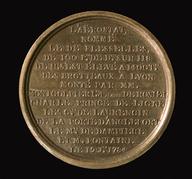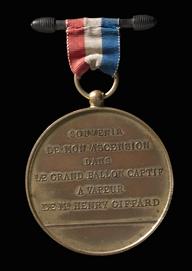



![Silver tone [plated metal] medallion with glass cover and](https://coimages.sciencemuseumgroup.org.uk/297/288/small_thumbnail_smg00009565.jpg)


![Silver tone [plated metal] medallion with glass cover and](https://coimages.sciencemuseumgroup.org.uk/297/288/medium_smg00009565.jpg)
Silver tone [plated metal] medallion with glass cover and Parkesine mount commemorating the birth Dec 21st 1805 and death Sept 16th 1869 of Thomas Graham. / J.W. Minton Sc. [1869-70?]. diameter 45mm, in mount diameter 58mm. obverse only, Head to L relief profile, signed below. The chemist Thomas Graham (1805-1869) showed that hydrogen readily penetrated the crystal lattices of certain metals, a process he called 'occlusion'. Iron, platinum and especially palladium are affected. He supposed that hydrogen gas was the vapour of a very volatile metal hydrogenium which formed an alloy with palladium.
Details
- Category:
- Coins, Medals & Tokens
- Object Number:
- 1964-490
- Materials:
- silver, (plate?), Parkesine (xylotile) and glass
- Measurements:
-
overall: 45 mm,
- type:
- medal
- credit:
- McLachlan, T.




